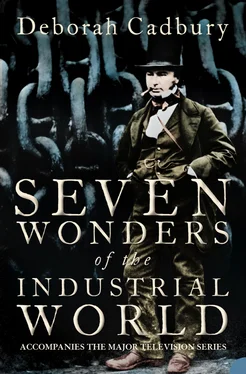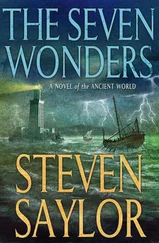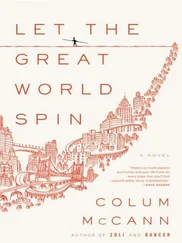The most immediate practical concern for Brunel was where to build and launch his ship. The contract had stipulated that the ship be built in a dry dock but Scott Russell’s yard was too small for Brunel’s vast project. Scott Russell, needing more space, rented Napier shipyard adjoining his at Millwall to accommodate the construction of the hull. They realised that building the ship on an end slip was impossible; the bow would be 100 feet in the air during construction. It was also out of the question to launch a 700-foot-long ship stern first in the traditional way, when at that point the river was a mere 1,000 feet wide. After much deliberation, Brunel decided to build the ship on the bank parallel to the river and launch her into the Thames sideways down a gentle slope. To prepare the site, 2,000 oak beams up to 40 feet long were piled 5 feet apart into the shore, leaving 4 feet above ground. Further packing was then added and the flat-bottomed hull would rest on two large cradles.
In March 1854, just as they were finally ready to start construction work on the hull, Britain entered the Crimean War. With supplies needed for the military, the price of iron rose rapidly. A few months later, Scott Russell faced another major setback: the unexpected death of Charles Geach. ‘The Honourable Member had returned from his Scotch shooting in unusually good health,’ reported The Times . However, he had been suffering from a dangerous infection in his leg. A change for the worse occurred, ‘and after much suffering borne with the greatest fortitude and resignation, Mr Geach expired at half past 4 o’clock yesterday afternoon’.
This was a disaster for Scott Russell. Geach was crucial to the iron supply and was the one person who had accepted flexible terms of payment on this immensely expensive project. Scott Russell’s solution was a dangerous one. Unknown to Brunel and the other directors, he secretly mortgaged his shipyard, thereby putting the Great Ship at risk. Brunel had not worked closely on a financial venture before with Scott Russell and was unaware, at this point, of the danger signals beginning to emerge that could affect the future of his ‘Great Babe’, as he affectionately nicknamed his new creation.
In spite of the precarious financial situation, the hull was slowly rising, a massive dark shape against the water and sky. It was being built at a big southerly bend in the river at Millwall on the Isle of Dogs, about six miles down river from Westminster and 40 miles to the open sea. This was an undeveloped part of London, previously the haunt of wildlife, with little but ‘marshy fields and muddy ditches, with here and there, a meditative cow cropping herbage’. Now it was the site of a technological revolution that would inspire shipbuilding for years to come.
Brunel’s original idea for the design of the hull was evolved from lessons learnt in his bridge-building days. A key innovation was to have a double hull, heavily braced up to the water line, one hull inside the other and 2 foot 10 inches apart. These were to be constructed from 30,000 iron plates, each 3/ 4inch thick. The deck, too, would consist of two thicknesses of 1/ 2inch iron plate. Strength was further guaranteed by longitudinal and transverse bulkheads. According to Scott Russell, ‘the longitudinal system is carried throughout unbroken, without interruption by the bulk heads’ and the watertight transverse bulkheads, 60 feet apart the length of the ship, made her, it was hoped, virtually unsinkable. With this cellular double hull, the bulkheads and the strong watertight deck, Brunel compared the strength of the hull to that of a box girder.
This unique vessel was to be powered by both screw and paddle engines to give greater flexibility and manoeuvrability. The engines themselves would be giants, 40 feet high; the cylinders on the screw engines alone had a bore of seven feet by fourteen. And before the crankshaft for the paddle engines could even be made, new larger furnaces had to be built.
The giant hull was attended by an army more than a thousand strong of riveters, bashers and shipwrights. Men were busy inside, outside, high up, low down, creeping and crawling between the hulls, up at the bow, down at the stern, hammering, clanking, banging, carting iron, moving wood and hammering the rivets. Swarming all over the ship, they gave the impression of ants on a giant carcass. Depending on the light, men worked twelve-hour days and a skilled man could earn 30 to 40 shillings a week. There was no certainty of continued employment and plenty of men were waiting to step into the shoes of anyone who left their work.
The noise coming from the shipyard was deafening. The ringing sound of metal hitting metal reverberated throughout the hull. Two hundred riveting teams working both inside and outside the hull hammered unceasingly at a total of three million one-inch-thick, white-hot rivets. Each rivet would be held in place by a man on the other side of the plate. Children were employed as part of the team tending the forge and placing the heated rivets in the holes. They were particularly useful working in the double hull, where with limited space it was difficult for a man to manoeuvre. Working in the dark, confined space of the double hull, it did not do to lose concentration, even after a twelve-hour shift. One moment of carelessness could be paid for with a hand, or an arm, or a life.
Accidents were commonplace. It was all too easy to miss a step and, falling from a height, involve another man in disaster in the overcrowded conditions. One worker who was making bolts got his hands tangled in the machinery and torn completely from their sockets at the wrist. In his case, amputation of both arms was the only solution. Yet another man, curious about the working of a piledriver, was bent over examining the machinery when the hammer came down, flattening his head. Children were particularly vulnerable. They could be working in the yard as young as nine or ten. One unfortunate child fell from a height and was impaled on an upright iron bar. According to one witness, ‘after he was dead, his body quivered for some time’. There was always another boy willing to take his place for a shilling or two. A rumour persisted at this time that a riveter and his boy had somehow been forgotten and were entombed alive in a section of hull. Months later, workers said they could hear the ghosts hammering, trying to escape. Most were sure this tragedy would put a curse on the ship.
As work progressed it became apparent that Brunel and Scott Russell, the two great men locked into building this ship together, were very different in style and temperament. Brunel was married to his work, always absorbed in every detail. He thought nothing of getting dirty in the course of a working day. His wife, Mary, known as ‘the Duchess of Kensington’ on account of her beauty and style, rarely saw him at their elegant London home because he worked eighteen hours a day. Scott Russell, on the other hand, had a more relaxed managerial style – he delegated. As he sat in his impressive office, he expected the chain of command to work perfectly around him. He did not expect to get his beautifully tailored clothes dirty and left the management of the site to his yard managers, Hepworth and Dixon, who were responsible for the shipwrights. Increasingly, Brunel and Scott Russell found themselves in disagreement.
As the work on the Great Ship progressed and her shape became more evident, the press began to take an interest. They estimated that the Leviathan or Great Eastern , as she became known, had greater dimensions even than Noah’s Ark. ‘ Great Eastern Fever’ began to spread throughout the country and the ship soon came to symbolise the ‘moral supremacy’ of the British Empire. Yet for all the growing national excitement, a serious rift between Brunel and Scott Russell was to emerge.
Читать дальше












